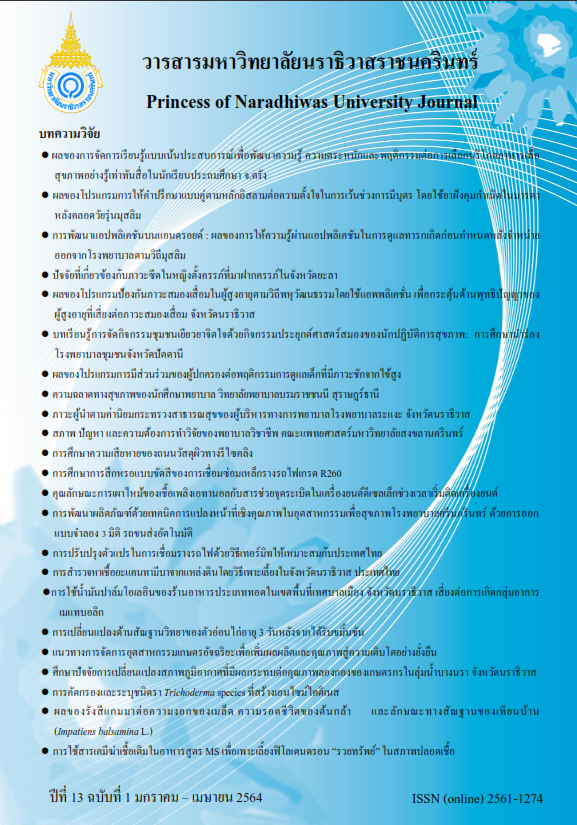Morphologic Changes of the 3-day-old Chick Embryos after Curcumin Exposure
Keywords:
Curcumin, Chick embryo, Teratogenic effectAbstract
Curcumin is a medicinal plant enlisted in the National List of Essential Medicines (Issue 2) B.E.2012, that has been used to treat flatulence, which is common in pregnancy especially during the first trimester. The aim of this study was to monitor morphological changes of the embryos in 3-day-old chicks exposed to curcumin 20, 40, and 60 mg/l. A total of 94 fertilized Rhode Thai eggs were divided into 5 groups: non-injection group, corn oil group, Cur-20, Cur-40 and Cur-60 received 0, 20, 40 and 60 mg/l of curcumin respectively. All eggs were injected solutions into yolk sac and incubated at a temperature of 37±0.5ºC. On day 3 of development, all eggs were then opened to observed morphological changes including cephalic region, limbs, caudal region and trunk. The data were analyzed by using Fisher’s Exact test to compare between group. The mortality percentage in chick embryos that exposed to curcumin 20, 40, and 60 mg/l were not statistically different when compared to non-injection group. The chick embryos exposed to curcumin 20 mg/l showed abnormal development of body curvature. The chick embryos exposed to curcumin 40 mg/l found abnormal development of cephalic region and closure failure of neural tube. Partial development of cephalic region and limb buds absence were observed in chick embryos exposed to 60 mg/l.
References
Ahmed, M., Hwang, J. H., Choi, S., & Han, D. (2017). Safety classification of herbal medicines used among pregnant women in Asian countries: a systematic review. BMC Complementary and Alternative Medicine, 17(1), 489.
Chen, C.C., Hsieh, M.S., Hsuuw, Y.D., Huang, F.J., & Chan, W.H. (2010). Hazardous effects of curcumin on mouse embryonic development through a mitochondria-dependent apoptotic signaling pathway. International Journal of Molecular Sciences, 11(8), 2839 - 2855.
Christensen, V.L. (2001). Factors associated with early embryonic mortality. Worlds Poult. Sci. J., 57, 359 - 372.
Evaluation of the joint FAO/WHO expert committee on Food additives (JECFA). (2019). Curcumin. Retrieved November 7, 2020 from https://apps.who.int/food-additives-contaminants-jecfa-database/chemical.aspx?chemID=638
Forster, D.A., Denning, A., Wills, G., Bolger, M., & McCarthy, E. (2006). Herbal medicine use during pregnancy in a group of Australian women. BMC Pregnancy and Childbirth, 6, 21.
Hamburger, V., & Hamilton, H.L. (1992). A series of normal stages in the development of the chick embryo. 1951. Developmental Dynamics: an Official Publication of the American Association of Anatomists, 195(4), 231 - 272.
Hill, M.A. (2018). Embryology Carnegie Stage Comparison. Retrieved November 6, 2020 from https://embryology.med.unsw.edu.au/embryology/index.php/Carnegie_Stage_Comparison
Huang, F.J., Lan, K.C., Kang, H.Y., Liu, Y.C., Hsuuw, Y.D., Chan, W.H., & Huang, K.E. (2013). Effect of curcumin on in vitro early post-implantation stages of mouse embryo development. European Journal of Obstetrics, Gynecology, and Reproductive Biology, 166(1), 47 - 51.
Institutional Animal Care and Use Committee (IACUC). (2019). Policy for use of avian embryos. Retrieved July 11, 2020 from http://ird.skru.ac.th/2558/file/km4.pdf
Laelago, T. (2018). Herbal medicine use during pregnancy: benefits and untoward effects. London: IntechOpen.
Mishrikoti, H.P., & Kulkarni, U.K. (2018). An early chick embryo as learning model for study of embryology. National Journal of Clinical Anatomy, 7(04), 177 - 182.
National drug system development committee. (2019). Thailand national list of essential medicine BC 2019 (2019, 17 April). Royal Thai Government gazette,136(95ง), 1 - 283.
Roongruangchai, J., Viravud, Y., Plakornkul, V., Sripaoraya, K., Jorakit, W., & Roongruangchai, K. (2018). The Teratogenic Effects of Dichlorvos on the Development of Chick Embryos. Siriraj Medical Journal, 70(1), 44 - 52.
Wu, J.Y., Lin, C.Y., Lin, T.W., Ken, C.F., & Wen, Y.D. (2007). Curcumin affects development of zebrafish embryo. Biological & Pharmaceutical Bulletin, 30(7), 1336 - 1339.



